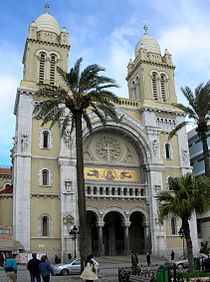Rite Latin Rite Area 164,000 km² | ||
 | ||
Population- Total- Catholics 10,955,000(number unknown) (1%) Cathedral Cathedral of St. Vincent de Paul | ||
The Archdiocese of Tunis was founded on 10 November 1884 under the name "Archdiocese of Carthage", with territory corresponding to that of the then French protectorate of Tunisia. On 9 July 1964, it became a territorial prelature, with the name "Prelature of Tunis". It was made a diocese, keeping the name of Tunis, on 31 May 1995, and raised to the rank of archdiocese on 22 May 2010.
Contents
History
In 1684, Pope Urban VIII established an apostolic prefecture at Tunis for Ottoman Tunisia, which Pope Gregory XVI raised to the rank of an apostolic vicariate in 1843.
In 1881, Tunisia became a French protectorate, and in the same year Charles Lavigerie, who was archbishop of Algiers, became apostolic administrator of the vicariate of Tunis. In the following year, Lavigerie became a cardinal. He "saw himself as the reviver of the ancient Christian Church of Africa, the Church of Cyprian of Carthage", and, on 10 November 1884, was successful in his great ambition of having the metropolitan see of Carthage restored, with himself as its first archbishop. In 1053, Pope Leo IX settled a dispute about primacy in the Roman province of Africa between the bishops of Carthage and Gummi by declaring that, after the Bishop of Rome, the first archbishop and chief metropolitan of the whole of Africa is the bishop of Carthage nor can he, for the benefit of any bishop in the whole of Africa, lose the privilege received once for all from the holy Roman and apostolic see, but he will hold it until the end of the world as long as the name of our Lord Jesus Christ is invoked there, whether Carthage lie desolate or whether it some day rise glorious again." In line with this, Pope Leo XIII acknowledged the revived Archdiocese of Carthage as the primatial see of Africa and Lavigerie as primate. (The statement by Auguste Boudinhon that the acknowledgement was made in 1893, the year after Lavigerie's death, if not mistaken, is a reference to some renewed recognition.) From then until 1964, the Annuario Pontificio presented the see of Carthage as "founded in the 3rd century, metropolitan see of Proconsularis or Zeugitana, restored as archbishopric 10 November 1884".
In July 1964, pressure from the Tunisian government under President Habib Bourguiba, which was in a position to close down all the Catholic churches in the country, forced the Holy See to accept an agreement of the type known as a modus vivendi, a term that literally means "a way of living". This particular agreement was unofficially described as instead a modus non moriendi ("a way of not dying"). By it, all but 5 of the country's more than 70 churches were handed over to the state, including what had been the cathedral of the archdiocese, while the state, for its part, promised that the buildings would be put only to use of public interest consonant with their previous function.
In view of the changed situation, the Holy See considered the ancient see of Carthage as no longer restored to residential status, and listed it thenceforth as a titular see. The residential archdiocese's territory became that of the Territorial Prelature of Tunis, established on 9 July 1964. The first archbishop of the titular see, Agostino Casaroli, was appointed on 4 July 1967. The Annuario Pontificio of that period described the titular archiepiscopal see of Carthage as "founded in the 3rd century, metropolitan see of Proconsularis or Zeugitana, restored as an archiepiscopal see on 10 November 1884, titular archbishopric 9 July 1964". The history of the territorial prelature was given as "founded 9 July 1964, previously an archbishopric under the name of Carthage founded 10 November 1884".
The Prelature was elevated to Diocese in 1995. In 2010, it was promoted to Archdiocese. The summary of the history of the residential archdiocese of Tunis now given in the Annuario Pontificio is: "archbishopric under the name of Carthage 10 November 1884; Prelature of Tunis 9 July 1964; diocese 31 May 1995; archbishopric 22 May 2010." The ancient see of Carthage, on the other hand, being no longer a residential bishopric, is listed by the Catholic Church as a titular see in the same publication as distinct from the modern see of Tunis. As a summary history of the titular see of Carthage it states: "founded in the 3rd century, metropolitan see of Proconsularis or Zeugitana, restored as an archiepiscopal see on 10 November 1884, titular metropolitan see 9 July 1964".
The cathedral of the archdiocese of Tunis is the Cathedral of St. Vincent de Paul. What was the cathedral of the archdiocese of Carthage, the Saint Louis Cathedral (Carthage), is owned by the Tunisian state and is used for concerts.
Comparison with the ancient see of Carthage
The ancient see of Carthage, which is now a titular see, was much less extensive than the archdiocese of Tunis. The territory of the archdiocese is coterminous with that of Tunisia, and thus corresponds approximately to that of the entire Roman provinces of Africa Proconsularis (Zeugitana) and Byzacena. The ancient diocese was only one of many bishoprics within the former of these Roman provinces.
On the other hand, the archdiocese does not enjoy the influence that the ancient diocese had over a large number of bishoprics in an area encompassing not only today's Tunisia but also much of Algeria.
Apostolic Vicar of Tunis, c. 1843–1884
Archbishops of Carthage, 1884–1893
Archbishops of Carthage and Primate of Africa
Auxiliary Bishop: Bishop Jean Saint-Pierre (1930.05.28 – 1937.08)
